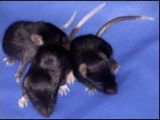French researchers have found that mice can pass on traits to their offspring even if the gene behind those traits is absent! They think that maybe the characteristics are inherited via RNA, instead of DNA.
The mouse can have a spotted or an unspotted tail. This is determined by a certain gene - the normal gene leads to a dark tail, the mutant gene leads to a spotty tail. Mendel's law says that this characteristic should be determined only by the combination of genes inherited from mother and father.
But scientist from the French Institute of Health and Medical Research (Inserm) and the University of Nice-Sophia Antipolis found otherwise. They took mice having a pair of normal genes and crossed them with mice having one mutant gene (and thus a spotted tail).
According to Mendel, the offspring should have been either with two normal genes or with one mutant and one normal gene. But in reality some offspring had two mutant genes (these died shortly after birth). Moreover, some of the mice with two normal genes also had spotted Tails.
"We were very surprised to see this," said Professor Minoo Rassoulzadegan, a geneticist at the University of Nice and lead author on the paper. After further investigation, the scientists suggested the transfer of RNA molecules as the cause.
RNA plays an intermediary role between DNA and the production of proteins. Scientists found that the mutant gene produces large amounts of messenger RNA molecules which accumulate in the sperm of these mice. So although the offspring had two normal genes it could develop the proteins that lead to a spotted tail.
"We then looked to see what would happen if a preparation of RNA from the sperm [of a mutant mouse] was injected into a fertilized mouse egg," explained Professor Rassoulzadegan. "It was clear when we saw the mice born after this injection that RNA could be responsible for the inheritance of the white tail phenotype."
Such a departure from Mendel's laws of inheritance has been previously observed in plants, but this is the first time it has been shown in animals.
In a commentary on the new research, also published in Nature, Professor Paul Soloway from Cornell University in the US writes: "A particularly intriguing possibility is that such RNAs regulate other non-genetic modes of inheritance, such as metabolism or behavioral imprinting."
Although researchers looked only at mice insofar, the findings probably also apply to humans. "This brings valuable information about modification of our genome," said Rassoulzadegan," and perhaps this research may eventually help us to understand why we are all so different from each other."

 14 DAY TRIAL //
14 DAY TRIAL // 
